|
In Depth Analysis of American Income and Taxation
By
 - September 23, 2003 - September 23, 2003
Updated - November 17, 2004
The following is an in depth analysis of income and
taxes in America, primarily over the past 20 years. The data shows
that the tax burden has been shifted from both the highest and
lowest income receivers towards middle income receivers,
specifically upper middle income receivers, those in the 75th to
94th percentile, i.e. those making between about $65,000 and
$150,000 a year.
The graph below shows the average pre-tax incomes of the
various groups. A quintile represents 20% of the population
who file income taxes, so the lowest quintile represents the lowest
20% of income taxes returns that were filed. In the year 2000
128,227,000 income tax returns were filed, so one quintile would
represent about 25,000,000 filers.
The top 1% represents the widest range of incomes,
ranging from $373,000 to hundreds of millions or billions of dollars
of income for one year. The average Adjusted Gross Income (AGI)
filed for the top 400 income receivers in America for 2000 was
$173,915, 617. AGI represents all forms of income such as
payroll, capital gains, and gift income minus certain deductions. In
2000 72% of AGI for the top 400 income filers came from capital
gains.
As you can see from the graph below, despite the fact
that people tend to think of professionals such as doctors and
lawyers who make two or three hundred thousand dollars a year as
being "rich", the incomes of those professionals are closer to that
of the average middle class school teacher than they are to those of
the average or above average income receiver in the top 1%.
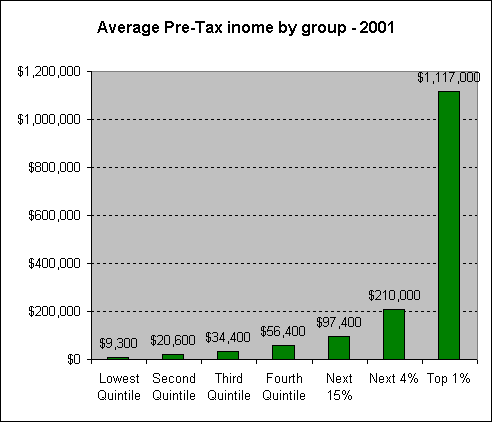
The following graph shows the share of pre-tax national
income that the various groups receive. The 59% segment
represents the top quintile, which is broken down into its
representative parts in the bar graph to the right.
Essentially this is showing that the top 20% received well
over half of national income in 2001, and that the top 5% (Next 4%
and Top 1% combined) received 33% of national income. The
bottom 80% of tax filers in America received 41% of national
income.
By looking at the above graph and the one below you can
see roughly what the income was of the those in each segment.
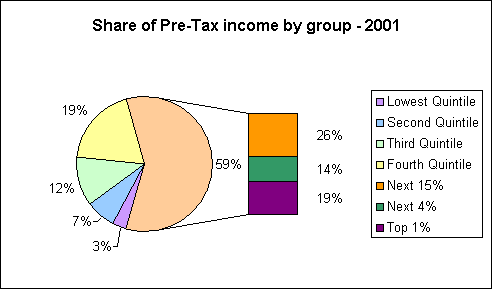
This next graph shows the change in tax burden for each
group due to the 2001 tax relief program of President George Bush.
Virtually everyone got some form of tax cut, but because some groups
got higher cuts than others there was a change in the
percentage of overall national income taxes that falls on
each individual. Some people are now carrying a smaller
portion of the total tax burden than they were prior to the tax
relief and some are carrying a larger portion of the total
burden. This graph shows who's load was lightened in reference
to the entire tax burden.
As you can see the top 1% did indeed receive the largest
decrease in their tax burden. The tax burden was generally
shifted to middle and upper middle income receivers by the Economic
Growth and Tax Relief Reconciliation Act of 2001.
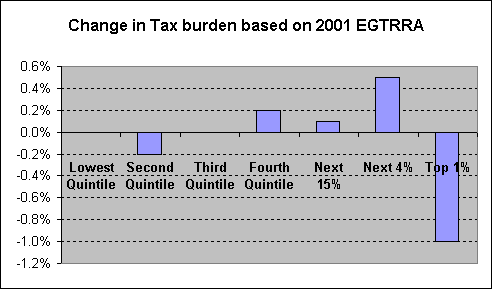
http://www.taxpolicycenter.org/TaxFacts/overview/egtrra.cfm
The following graphs deal with the distribution of the
three major types of income, Labor, Capital, and Transfer. The
income being used here is Family Economic Income (FEI), which
includes more types of income than the more typically used cash
income measures.
Labor income includes pre-tax wages, fringe benefits
(employer provided healthcare, etc), and self employment income.
Capital income includes interest, pre-tax corporate profits,
non-stock capital gains, pension and IRA benefits, and receipts on
IRA and life insurance assets (note that profits from the sale of
stocks are not reflected in this data). Transfer income
includes Social Security, Supplemental Security Income (SSI),
Temporary Assistance for Needy Families (TANF), Low Income Home
Energy Assistance (LIHEA), veteran's compensation, workers
compensation, and food stamps. For a further explanation see:
http://www.ustreas.gov/ota/ota85.pdf page 18.
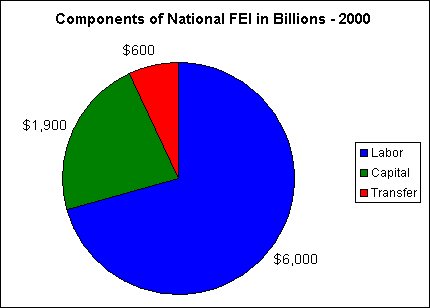
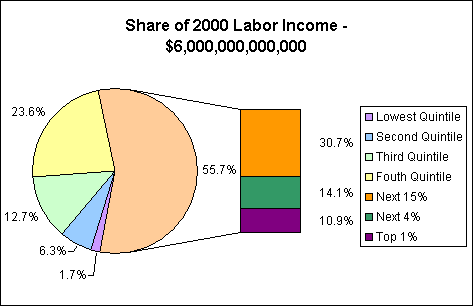
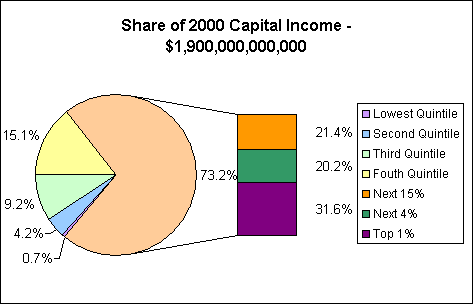
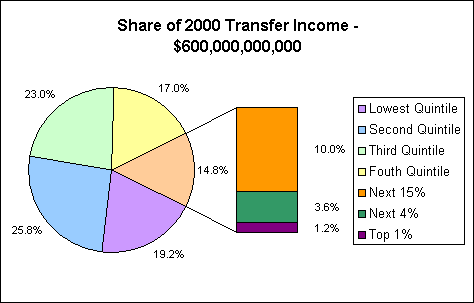
The graph below shows the percentage of each of type of
income received by each percentile of the population, starting at
the 10th percentile. So, for example, the 50th percentile received
approximately 0.64% of the nation's income, which is to say that the
ratio of households to national FEI dollars is 1:0.64, or all of the
households in the 50th percentile receive about 3/5ths of one slice
of the national FEI. The X axis for the graph is on the 1% line.
Where the series crosses the X axis is where families receive a 1 to
1 share of the national FEI. For labor income this point is at about
the 65th percentile, which is to say that this is the point where
income distribution is equal to family distribution. One way to see
this would be to call this the "fair share" point. Families behind
this point are receiving a smaller portion of national income than
they represent numerically, households in front of it are receiving
a larger percentage of income than they represent numerically.
If, in theory, everyone in America received the same amount of labor
income, what we would all receive is the amount of income that those
in the 65th percentile currently receive.
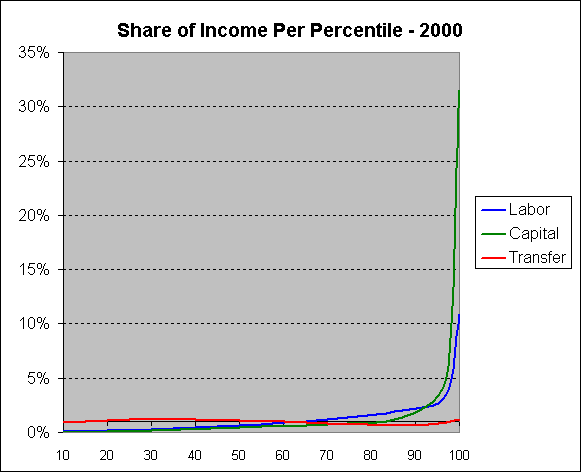
The graph below shows the composition of income for each
of the groups, i.e. the portion of income that is of each type. The
table below the graph gives the dollar value in billions for each of
the groups. For example the Lowest Quintile receives for $102
billion dollars of the nation's total labor FEI and $115 of the
nation's total transfer FEI. Even though transfer income makes up a
smaller share of the Second and Third Quintile's income than the
Lowest Quintile, the Second and Third Quintile receives a larger
amount of transfer income in terms of dollars. Remember that Social
Security makes up a large portion of the transfer income for all
quintiles.
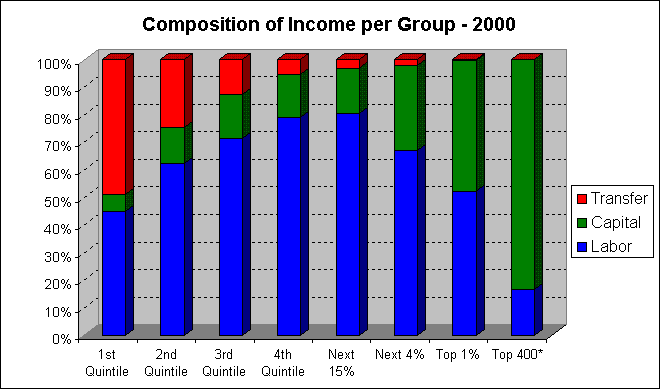
* The Top 400 data comes from a separate source and is
based on AGI, and is thus not directly comparable to the FEI data,
however it is close enough for a general comparison.
|
Total Dollars in Billions per Group |
| Labor |
Capital |
Transfer |
Total |
| Lowest Quintile |
$102.00 |
$13.30 |
$115.20 |
$230.50 |
| Second Quintile |
$378.00 |
$79.80 |
$154.80 |
$612.60 |
| Third Quintile |
$762.00 |
$174.80 |
$138.00 |
$1,074.80 |
| Fourth Quintile |
$1,416.00 |
$286.90 |
$102.00 |
$1,804.90 |
| Next 15% |
$1,842.00 |
$406.60 |
$60.00 |
$2,308.60 |
| Next 4% |
$846.00 |
$383.80 |
$21.60 |
$1,251.40 |
| Top 1% |
$654.00 |
$589.00 |
$7.20 |
$1,250.20 |
This graph shows the three forms of income stacked on
top of each other to represent total income for each percentile,
allowing you to see what portion of what type of income makes up the
income for the population. The graph is made from seven data points,
which are marked by the vertical lines extending to the X axis.
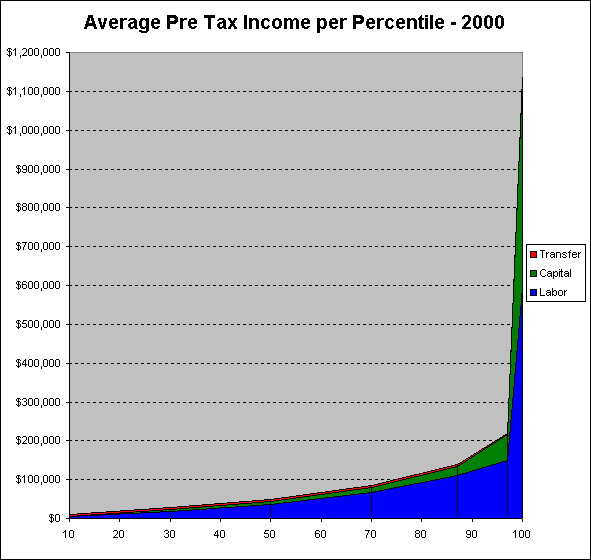
| Percetile |
Labor |
Capital |
Transfer |
| 10th |
$4,615.4 |
$601.8 |
$5,212.7 |
| 30th |
$18,173.1 |
$3,836.5 |
$7,442.3 |
| 50th |
$35,277.8 |
$8,092.6 |
$6,388.9 |
| 70th |
$67,109.0 |
$13,597.2 |
$4,834.1 |
| 88.5th |
$110,299.4 |
$24,347.3 |
$3,592.8 |
| 97.5th |
$148,421.1 |
$67,333.3 |
$3,789.5 |
| 100th |
$594,545.5 |
$535,454.5 |
$6,545.5 |
http://www.ustreas.gov/ota/ota85.pdf
The graph below shows the breakdown for the shares of
type of income for 2004 compared to the share of total federal
taxation that is levied on those forms of income. The small amount
of taxation on transfer income comes primarily from the taxation of
Social Security income. As you can see, income from labor is
disproportionately taxed. Although 71% of reported receipts in 2004
came from wages, 88% of federal personal taxes were raised from
wages. While 22% of personal income in 2004 came from capital
gains, only 11% of federal personal taxes were levied on this form
of income. This is because capital gains are taxed at a rate
significantly lower than wages. As the data above shows, capital
income goes disproportionately to the wealthiest Americans.
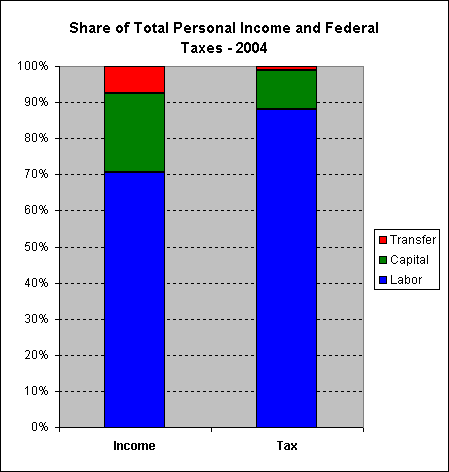
http://www.itepnet.org/earnan.pdf
In comparison to these figures we can see the 2000
incomes of George Bush and Dick Cheney: the vast majority of both of
their incomes coming from capital. Dick Cheney did not release his
entire tax filing so the exact figure of his gross income is not
known for 2000, just his adjusted gross income, AGI. For that reason
I am not able to calculate his federal income tax rate, however
George Bush paid 26.86% of his 2000 income to federal income tax.
*Reported AGI, not gross income.
Prior to World War II virtually all federal taxes were
paid by the wealthiest members of society. Less than half of
American workers paid any income tax at all prior to WWII. In order
to fund the war income taxes were increased and the majority of
workers had to pay income taxes for the first time, but even after
the war federal taxes on average Americans remained very low. As
federal tax rates on the wealthy were decreased starting in the
1960s, the tax burden on middle and low income Americans began to
grow.
While most people are aware of the rates of the
various income tax brackets, many people don't realize that you
actually pay a significantly lower portion of your income to taxes
than is indicated by the income tax bracket that you fall
into.
In 1979 the top income tax bracket was 70%, Reagan
then cut the top tax bracket to 50% and in his second term he cut it
again to 28%. It has since come back up as high as 39% under
Bill Clinton. However, no one actually pays these rates.
Those rates also only represent federal income taxes on earned
income, but there are also your Social Security taxes, capital gains
taxes, estate taxes, and excise taxes, etc. The graph below
shows the total effective tax rate of all federal taxes combined for
each of the groups: income, plus Social Security, plus estate, plus
excise, plus capital gains, etc.
As you can see from the graph, even those combined
rates are below what the rates are for the income tax brackets that
correspond to the groups. We all actually pay a much lower
amount in taxes than most people think we pay. As an example,
the income tax paid by even the top 400 receivers in 2000 was only
22% of their AGI, and that is for people averaging over 170 million
dollars a year in income, again that is partly because over 70% of
that group's income came from capital gains.
There is only one group that paid a higher rate of
federal taxes under Clinton than they were 20+ years ago in 1979
under Carter, and that is the group labeled Next 10%, or the 80th to
89th percentile; upper middle income receivers.
In 1979 the total effective federal tax rate for that
group was 25.4% and in 2001 it was 26.3%.
Another interesting thing that the graph reveals is
that during the Reagan years taxes were increased on the lower
income segments and dramatically decreased on the upper income
segments. The majority of this increase on the lower segments
came in the form of excise taxes.
What you can also see is that despite more than 20
years of political tough talk about taxes, the tax rates for the
middle income receivers have stayed roughly the same. As you
can see if you visit the link to the source data, excise and Social
Security taxes have increased significantly on middle income
receivers over the years pretty much negating any decrease in income
taxes. The most significant change in tax rates has been for
the top 1%, whose overall federal tax liabilities as a percentage of
AGI are now significantly less than they were in 1979, even though
they did come back some up during the 90s.
Federal tax rates under George W. Bush were reduced
across all income levels, however the reductions were the greatest
on the top 1%. The change for the top 1% was a reduction of 6.8%,
while the reduction for the bottom 80% averaged 1.9%. Despite these
federal tax reductions, taxes have generally increased at the state
and local level to make up for the reductions in federal funding,
effectively negating most of the federal tax reductions.
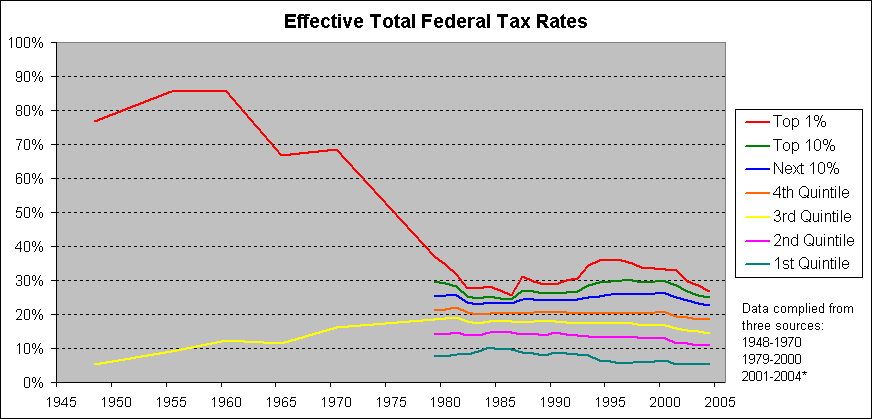
http://www.cbo.gov/showdoc.cfm?index=4514&sequence=3&from=0
http://www.cbo.gov/showdoc.cfm?index=5746&sequence=1#pt4*
| |
Top 1% |
Top 5% |
Top 10% |
Fifth Quintile |
Fourth Quintile |
Third Quintile |
Second Quintile |
Lowest Quintile |
|
Effective Individual Income
Tax Rate |
| 1979 |
21.8% |
19.0% |
17.4% |
15.7% |
10.1% |
7.5% |
4.1% |
0.0% |
| 2000 |
24.2% |
21.6% |
19.7% |
17.5% |
8.1% |
5.0% |
1.5% |
-4.6% |
|
Effective Social Insurance
Rate |
| 1979 |
0.9% |
2.8% |
4.2% |
5.4% |
8.5% |
8.6% |
7.7% |
5.3% |
| 2000 |
1.9% |
3.8% |
5.0% |
6.3% |
10.4% |
9.6% |
9.4% |
8.2% |
|
Effective Corporate Income
Tax Rate |
| 1979 |
13.8% |
9.5% |
7.4% |
5.7% |
1.6% |
1.4% |
1.2% |
1.1% |
| 2000 |
6.8% |
5.4% |
4.5% |
3.7% |
1.0% |
1.0% |
0.6% |
0.5% |
|
Effective Federal Excise
Tax Rate |
| 1979 |
0.5% |
0.6% |
0.7% |
0.7% |
0.9% |
1.1% |
1.3% |
1.6% |
| 2000 |
0.3% |
0.4% |
0.5% |
0.6% |
0.9% |
1.2% |
1.4% |
2.2% |
|
Total Effective Federal Tax
Rate |
| 1979 |
37.0% |
31.8% |
29.6% |
27.5% |
21.2% |
18.6% |
14.3% |
8.0% |
| 2000 |
33.2% |
31.1% |
29.7% |
28.0% |
20.5% |
16.7% |
13.0% |
6.4% |
| 2004* |
26.7% |
25.6% |
24.9% |
23.8% |
18.5% |
14.6% |
11.1% |
5.2% |
The following graph shows the change in the share of
total federal tax liabilities among the various income groups
between 2000 and 2004. Similarly to the EGTRRA data from 2001, this
shows tax burden being shifted to the middle class.
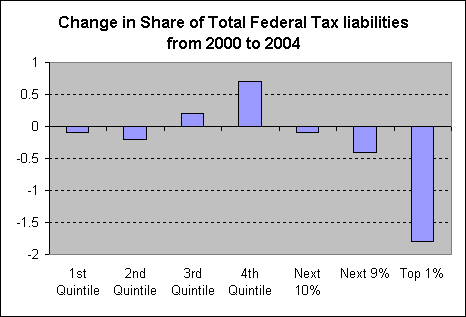
http://www.cbo.gov/showdoc.cfm?index=5746&sequence=1#pt4
The graph below shows slightly longer term household
income trends. What is not reflected in this data is the
number of workers per household, which has generally risen among all
income brackets over the past 50 years, especially among the middle
class. As you can see though the incomes reported by the
bottom 80% of American working households have changed only slightly
since the 1960s even with an increase in two and three worker
households, while the incomes of the top 5% of households has gone
up dramatically.
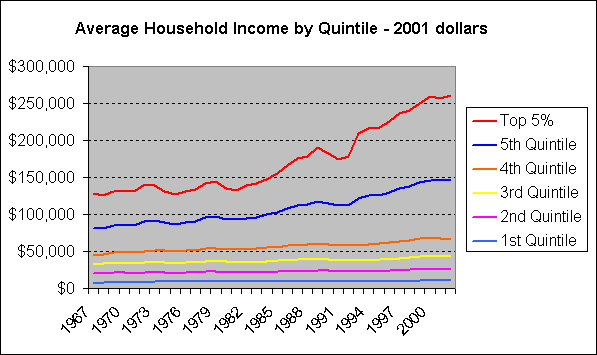
http://www.census.gov/hhes/income/histinc/ineqtoc.html
This graph is very similar to the one above, however
it does show the top 1% broken out as a separate series, and as you
can see that is where the most dramatic rise in income occurs.
The graph below is slightly different in some other ways as well.
This data is adjusted for household size, unlike the graph above,
and the range of data is not as great, it only goes back to 1979.
This graph is also significant because it shows after tax
income, so this is what was taken home after all federal taxes were
paid. Below the graph is a table showing the data for 1980 and 2000,
and below that is a row titled "Even", which shows what incomes
would have been like in 2000 if the average income growth (1.4
times) for that period had occurred evenly.
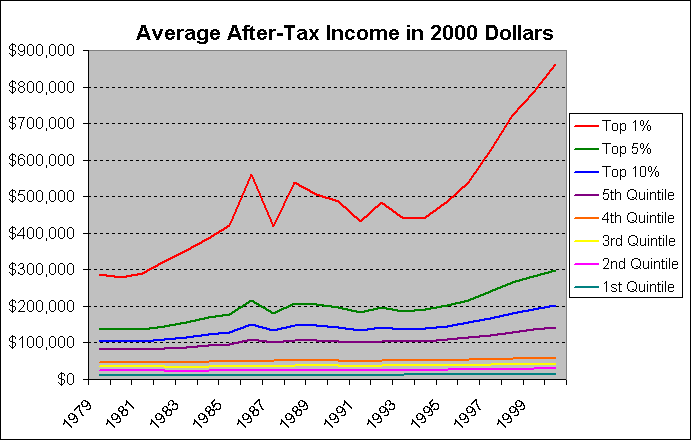
http://www.cbo.gov/showdoc.cfm?index=4514&sequence=3&from=0
|
Average After-Tax Income by
Quintile |
| |
Top 1% |
Top 5% |
Top 10% |
5th Quintile |
4th Quintile |
3rd Quintile |
2nd Quintile |
1st Quintile |
| 1980 |
$280,300 |
$135,500 |
$103,600 |
$81,500 |
$46,100 |
$35,200 |
$24,600 |
$12,200 |
| 2000 |
$862,700 |
$299,400 |
$201,400 |
$141,400 |
$59,200 |
$41,900 |
$29,000 |
$13,700 |
|
Even |
$392,557 |
$189,700 |
$145,040 |
$114,100 |
$64,540 |
$49,280 |
$34,440 |
$17,080 |
Here we get an even longer range view of income
trends. This shows after tax income in 2000 dollars going back to
1913 for the top 1% and the average for the remaining bottom 99%.
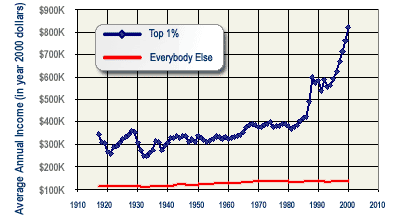
http://www.aflcio.org/corporateamerica/paywatch/
Below we can see the median income of American workers
since the 1950s. The median income is the income of the middle
segment of the working population. What this shows is that for
men there has been a general stagnation in terms of income for the
average American worker since the 1970s.
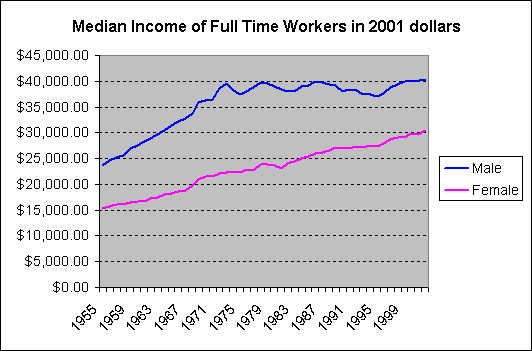
http://www.census.gov/hhes/income/histinc/ineqtoc.html
The graph below shows change in family incomes for two
distinct periods in American history: the immediate post-war period,
and then the post-Reagan period. During the post-war period from
1947 to 1979 American family incomes all rose together at relatively
equal rates, with the biggest gains among the poor and middle-class.
Since the Reagan era, income growth has been dramatically isolated
among the top 5%. The small gains for the poor and middle-class are
actually less impressive than this graph shows because of the large
increase in two and three worker households since 1980 among those
groups. Much of the small increase in family incomes for the bottom
80% during the post-Reagan era has been due to the rise in working
women.
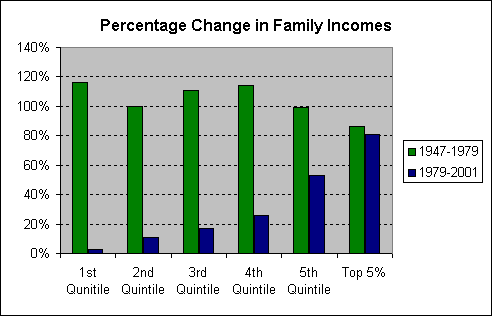
http://www.faireconomy.org/research/income_charts.html
This graph can be a little tricky to read, I have the
top income receiver at the bottom and the bottom at the top. I
did that so that you can more easily read the percentage of income
received by the top receivers. The blue, green, and red series
together make up the top 10%, red and green comprise the top 5% and
so on. The bottom half of income receivers are represented by
the aqua color, and as you can see they receive close to only 10% of
the total National Income. The graph shows which segments of
the income receivers have been gaining and loosing share. As
you can see, the top 50% accounts for more income today than they
did in 1980, but that does not mean that every segment of the top
50% has gained a share of income. In fact the only
segments to actually have gained in share of national income are
members of the top 5%. This can more easily be seen in the
summary table below the graph.
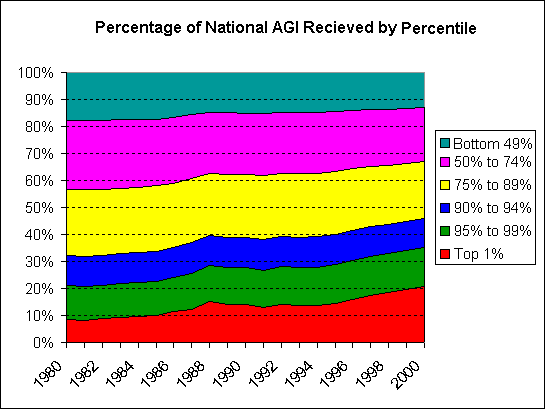
| Share of National AGI by
Percentile |
|
Top 1% |
95 to 99 |
90 to 94 |
75 to 89 |
50 to 74 |
Bottom 49% |
|
1980 |
8.46% |
12.55% |
11.12% |
24.57% |
25.62% |
17.68% |
|
2000 |
20.81% |
14.49% |
10.71% |
21.14% |
19.86% |
12.99% |
| Share of National AGI by
Group |
|
Top 1% |
Top 5% |
Top 10% |
Top 25% |
Top 50% |
Bottom 49% |
| 1980 |
8.46 |
20.01% |
32.13% |
56.70% |
82.32% |
17.68% |
| 2000 |
20.81 |
35.30% |
46.01% |
67.15% |
87.01% |
12.99% |
The two graphs below represent the data in
the Share of National AGI by Percentile
table above. Although not completely useful in themselves, as
a comparison between 1980 and 2000 the contrast becomes striking.
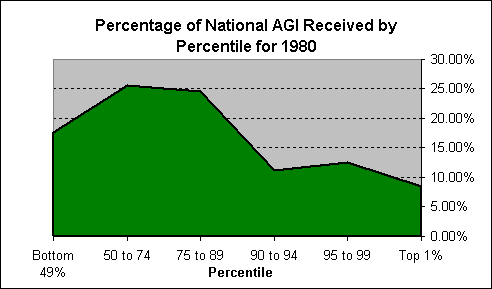
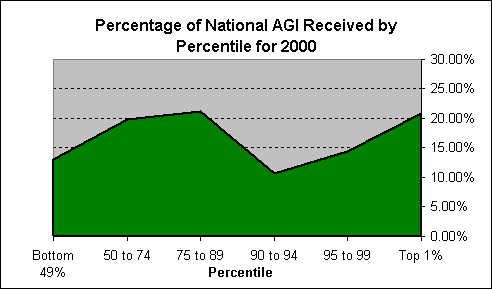
The graph below is of a similar nature to
the one above. It is showing the ratio of the share of income
to the population of each segment. In this case a value
of one would mean that that group received an equal portion of the
share of income to the portion of that group's share of the total
income tax filing population. In other words if that group
represents 20% of the population and received 20% of the after tax
income then that would be a one to one relationship, or a value of
one.
The labels are only for the 2000 values,
with the exception of the top 1% where I showed both values.
As you can see, between 1979 and 2000 the ratio of income per
household doubled for the top 1%, and the ratios for all members of
the bottom 95% decreased between 1979 and 2000. Keep in mind
that this is all showing after tax income, meaning the
income received after all federal taxes have already been paid.
Obviously claims that the top 1% are being over taxed or have been
unfairly taxed over the past 20 years cannot stand up in light of
this type of analysis.
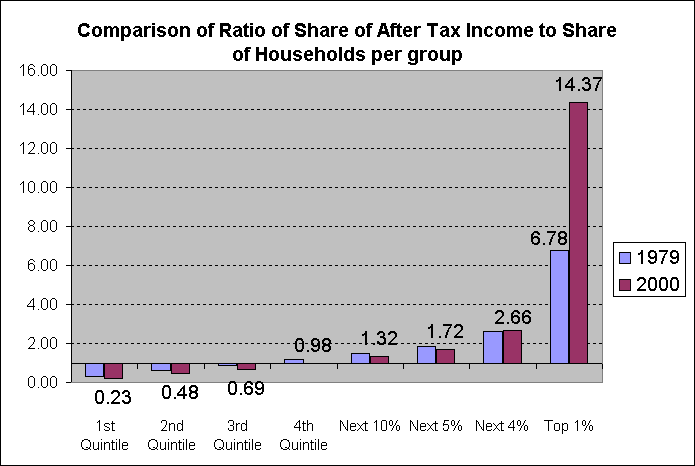
This graph is one of the most important
graphs because it shows the share of Total Federal Tax liability for
each group, unlike most graphs that you see which only show Income
Tax liability, as I will discuss later. Like the graph above
titled Effective Total Federal Tax Rates
this graph includes all forms of taxes, income taxes (payroll,
capital gains, etc), Social Insurance taxes, corporate taxes, and
excise taxes, so this takes all federal taxes into
consideration, not just income taxes.
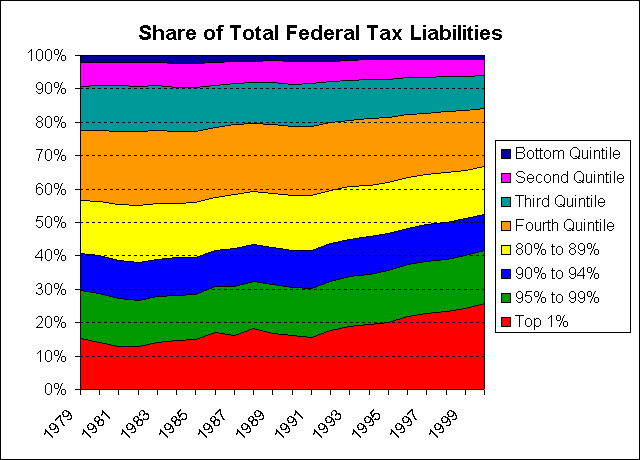
http://www.cbo.gov/showdoc.cfm?index=4514&sequence=3&from=0
| Share of Total Federal Tax
Liability |
|
Top 1% |
95 to 99 |
90 to 94 |
80 to 89 |
4th Quintile |
3rd Quintile |
2nd Quintile |
1st Quintile |
| 1979 |
15.4% |
14.2% |
11.1% |
15.7% |
21.0% |
13.2% |
7.2% |
2.2% |
| 2000 |
25.6% |
15.8% |
10.8% |
14.5% |
17.4% |
9.8% |
4.8% |
1.1% |
The graph below uses the data from the
Share of AGI by Percentile along with the
Share of Total Federal Tax Liability
tables to show the change in the ratio of the share of total tax
liability to the share of income. Because of the data that I
have available I'm only able to show this breakdown in detail for
the top 10%, and the bottom 90% is shown as one group.
The calculated values are below the graph.
The ratio of share of taxes to share of income for the top 1% in
1979 was 1.82. That means that in 1979 the top 1% paid a 1.82 times
greater share of total federal taxes than they received as a share
of total national income. They received 8% of the income and
paid 15% of the total federal taxes. In 2000 that ratio had
dropped to 1.23, meaning that the top 1% in 2000 was paying 1.23
times their share of income to the share of federal taxes.
They received 20% of the income and paid 25% of the federal taxes.
You can also see that in 2000 the ratios for
the bottom 95% of payers actually increased slightly from 1979.
This all indicates a shift in the total federal tax burden,
primarily to the upper middle income payers. Despite the fact
that this graph does not look like much, I consider it to be the
most important of all the graphs because it shows exactly the real
shift in total federal tax burden since 1979.
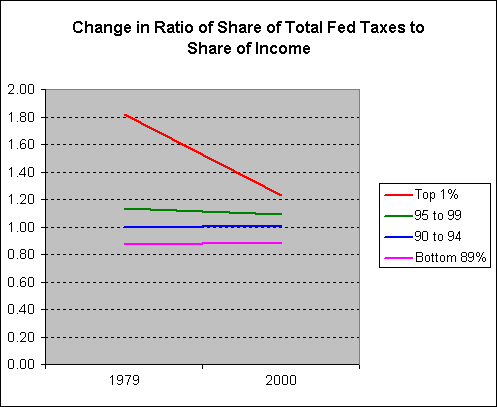
| Ratio of Share of Total
Federal Tax Liability to Share of National Income |
|
Top 1% |
95 to 99 |
90 to 94 |
Bottom 89% |
| 1979 |
1.82 |
1.13 |
1.00 |
0.87 |
| 2000 |
1.23 |
1.09 |
1.01 |
0.89 |
This next graph is one that shows data that
is somewhat popular among those that complain that the share of
income taxes paid by the top 1% has gotten too high. Unlike
the previous graph that shows all federal
taxes, this one only shows the share of federal
income taxes that are paid by each group. As the graph
shows the share of income taxes paid by the top 1% has gone
up dramatically, having been less than the share paid by the middle
income payers in the 1980s, the top 1% now pays a larger share of
income taxes than any of the other groups listed below. It
shows that middle income payers account for a smaller share than
even the 95th to 99th percentile payers. This of course is not
the whole story, because as we have already seen the share of income
for the top 1% has also gone up dramatically as well, and income
taxes are not the only federal taxes.
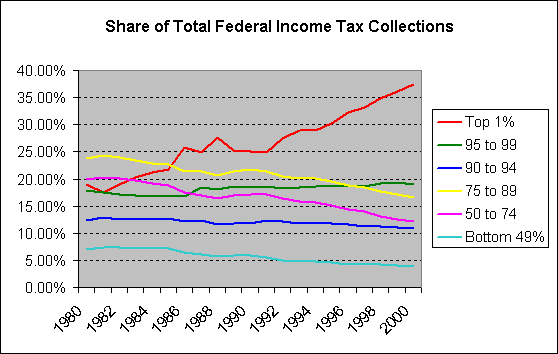
This graph now shows the real change in
income tax burden over time. This graph shows the ratio of share of
income taxes to share of income over time for each group. For
example, in 1980 the top 1% was paying 2.25 times their share of
federal income taxes to their share of national income. In
other words, they received 8.46% of the nation's income and paid
19.05% of the nation's income taxes. Their share of taxes was
2.25 times that of their share of income. Over time this ratio
has decreased and in 2000 they paid only 1.8 times their share of
income to their share of federal income taxes. So, contrary to
what many people try to claim, the federal income tax burden on the
top 1% is definitely decreasing. As you can see, the ratio of
share of taxes to share of income has decreased for all groups since
1980, but it has decreased the most for the top 1% and decreased the
least for the upper middle income payers.
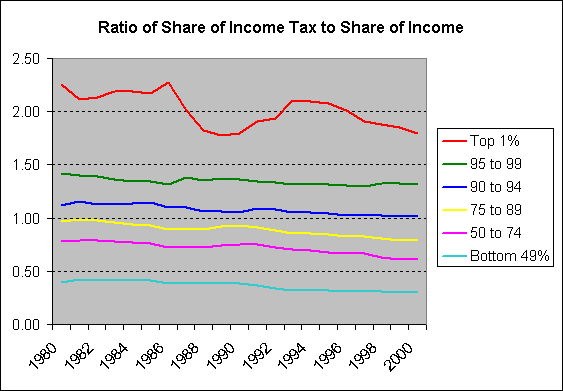
This graph shows overall income tax burden
flatness, as measured by the difference between the ratio of the
share of income taxes to share of income for the top 1% and the
bottom 49%. A value of zero would mean that all segments of
the population would be paying the exact same portion of federal
income taxes as the portion of federal income that they receive.
The closer the value is to zero the less progressive the income tax
structure is. The trend shows that since 1980 the income tax
system has become less progressive.
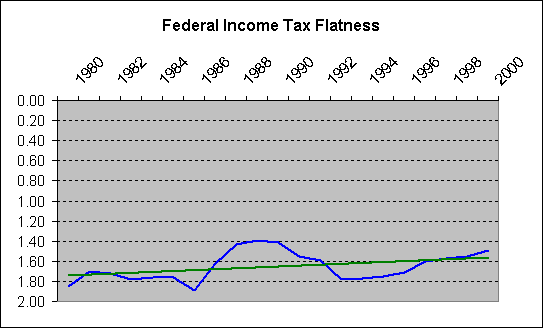
The next several graphs offer more analysis
of income and income tax trends.
Today we hear a lot about the fact that the wealthy pay the majority
of income taxes, and this is true, but as the data below shows, the
increase in share of national income by the top 1% has far outpaced
the increase in their share of the federal income tax burden.
Yes they pay a larger portion of income taxes now, but they also
receive a much larger portion of the national income.
This graph shows the difference in the share
of the national income between 1980 and 2000 by the various groups.
This graph does not show the percentage of that change, but rather
the change in percentage. For example the graph shows that the
top 1% received 12.35% more of the national income in 2000 than they
did in 1980.
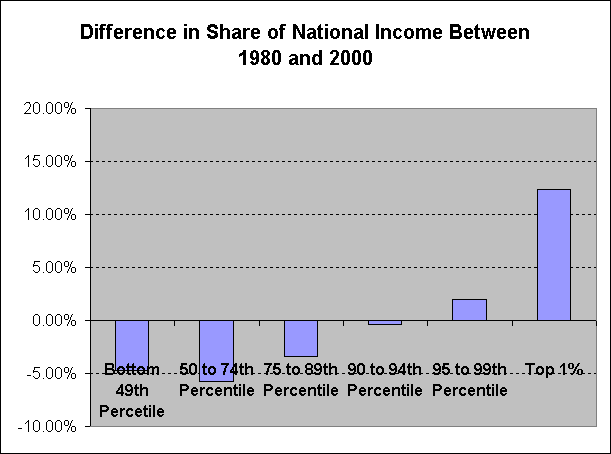
This graph shows the difference in the share
of national income taxes between 1980 and 2000. Like the graph
above this graph shows that the top 1% has also seen the largest
increase in the share of income taxes paid. You will also
notice that the difference between the share of the national income
taxes paid by the top 1% between 1980 and 2000 is greater than the
difference in their share of the income. This may look at
first like they are now paying a larger portion of the taxes than is
appropriate for the change in their share of the income, but this is
addressed by the next graph.
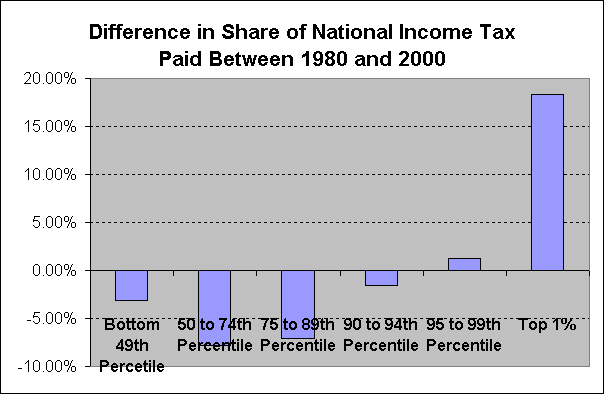
This graph shows the actual change in the
share of both income and income taxes between 1980 and 2000.
This graph shows that the change in the share of income for the top
1% was greater than the change in the share of the tax burden.
In other words, the top 1% received a 146% larger share of the
national income than they did in 1980 while their share of income
tax payment only grew by 96%, so the change in their share of
income grew at a higher rate than the change in their share of
income taxes.
Likewise, you can see that the change in the
share of income taxes paid by the lower income brackets dropped more
than the change in their share of income.
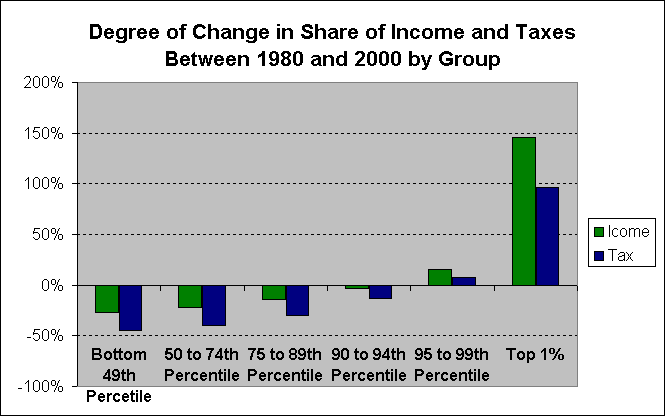
This graph is a measure of the change
between share of income vs. share of income taxes. This shows
that the top 1% has indeed seen the highest benefit between 1980 and
2000. The change in share of income received by the top 1% was
greater than the change in the share of income taxes by fifty
percentage points.
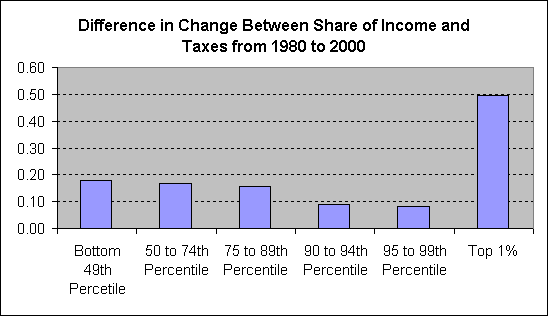
This graph now shows the degree of
difference in change between income taxes and income for each group.
Again, the top 1% comes out on top. So, not only has the top
1% seen the largest numerical gains in the share of national
income and the largest numerical gains in share of untaxed income,
but it has also seen the largest portion of gains in the share of
untaxed income in the United States since 1980. The lowest
income segments of the population have seen a decrease in share of
national income and share of national income tax, however the
difference between the change in share of income vs. taxes is not as
great as it is for the top 1%.
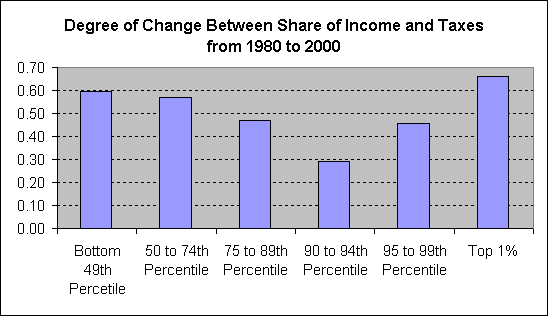
http://www.taxfoundation.org/prtopincometable.html
Federal Tax burden, as the data above shows,
has been shifted towards the upper middle income receivers since
1980, who have also seen a decrease in share of the national income.
The largest portion of this shift has come not from the lower income
brackets, but from the top 1%. The shift in tax burden is most
significant when you take all federal taxes into consideration, but the data
above shows that there has been a shift in the tax burden even among
just federal income
taxes.
Federal taxes are not the only taxes that
Americans pay however, we also pay state and local taxes as well.
Though the federal income tax was originally created as a highly
progressive tax, state and local taxes have been predominately
regressive historically, and remain so today. Rates of taxation, and
how progressive or regressive local taxation is, varies from state
to state, and even among cities and counties, however, most state
and local tax systems are regressive.
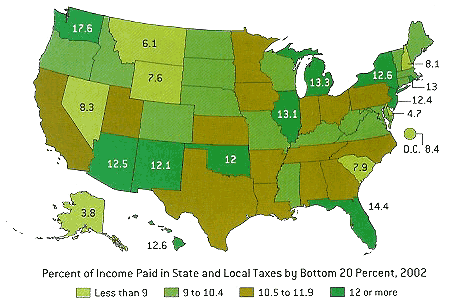
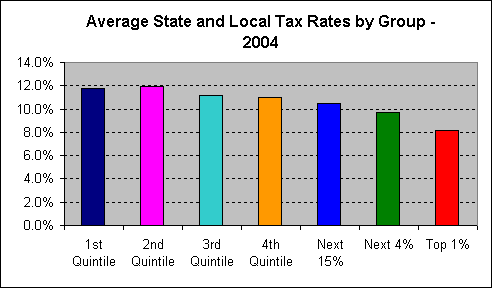
Now, after all of the discussion of federal
taxation, and showing that federal taxation itself is becoming
increasingly less progressive, the graph below shows total effective
tax rates by group including all forms of taxation: federal, state
and local. As you can see, when all taxes are taken into
consideration the tax rate for all income groups is very similar. In
fact, the total tax rate for the top 40% of Americans (those
receiving anywhere from $50,000 a year to $500,000,000+) is about
the same.
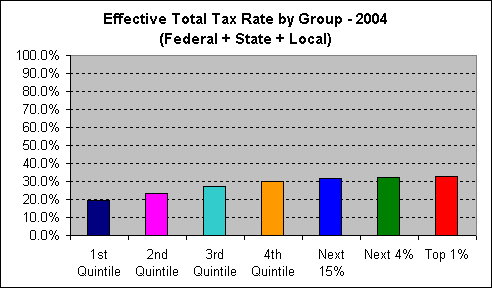
http://www.ctj.org/pdf/fsl2004.pdf
| 1st Quintile |
2nd Quintile |
3rd Quintile |
4th Quintile |
Next 15% |
Next 4% |
Top 1% |
| 19.7% |
23.3% |
27.0% |
29.8% |
31.6% |
32.2% |
32.8% |
This next graph, perhaps, sums everything up
best. Though so much is heard about how the wealthy pay a hugely
disproportionate share of taxes, this simply is not the case.
Virtually every time someone makes the claim that the wealthy pay a
disproportionate amount of the taxes they are discussing only
federal income taxes, because the federal income tax is the
most progressive major tax in America. However, when all
taxes are taken into consideration every group is currently paying a
roughly equal share of taxes to their share of national income, and
in fact the ratios of shares of income to shares of total taxes is
much more equal now than it has been any time since reasonably
reliable income and taxation data has been recorded, which covers
about the past 60 years. Traditionally in America, throughout
virtually all of American history, taxes have been levied most
heavily on the wealthy, and this was especially true during the
first 80 years of the 20th century. Prior to World War II income
taxes were levied exclusively on the wealthy.
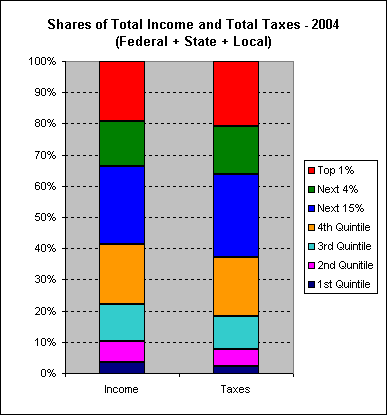
http://www.ctj.org/pdf/fsl2004.pdf
Below is a graph showing the historical
minimum wage and the unemployment rate in America together.
There has always been a lot of talk that the minimum wage
causes unemployment. Where is the proof? If this were true
then we should expect to see a rise in unemployment that corresponds
to every rise in minimum wage in the graph below, but in fact we see
almost the opposite of that. The truth is that many factors affect
the unemployment rate, not just minimum wage, and in many cases it
is not the minimum wage that is the determining factor in the
unemployment rate. In fact the Federal Reserve plays a large
part in regulating the unemployment rate through the use of interest
rates and other elements of fiscal policy. The Federal Reserve
attempts to maintain the unemployment rate around 5%, and considers
under 5% unemployment to be "too low". Because of this the
Federal Reserve's fiscal policy is often a major factor in buoying
the unemployment rate, not the minimum wage. As you can also
see, the time of lowest unemployment in America during the past 50
years was during the 1960s when in fact the minimum wage was at its
highest. The minimum wage today is now lower than it was in 1950
when adjusted for inflation.
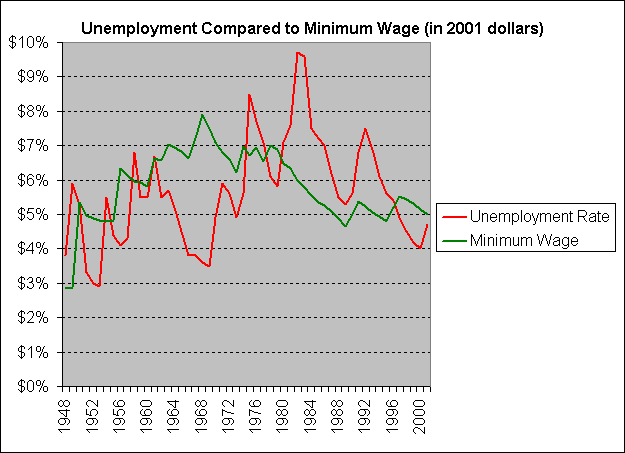
http://pw1.netcom.com/~rdavis2/awages.html
This graph shows both average hourly
earnings and the minimum wage together in 2001 dollars. As you can
see, both the minimum wage and average hourly earnings reached their
peak in the 1960s and 1970s. This graph does not go back any farther
than 1960, but for all practical purposes the peak shown here in
1973 is the historical peak for hourly earnings in America. See the
source data in the link below for details on hourly earnings.
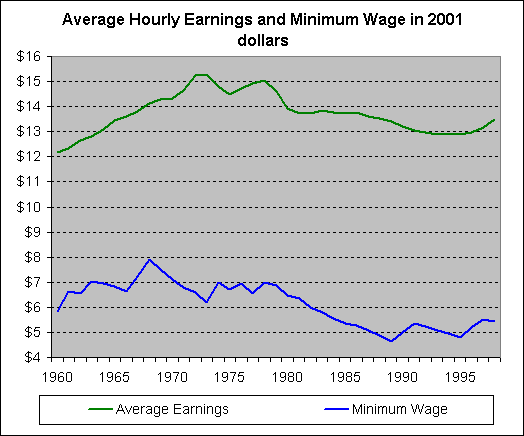
http://w3.access.gpo.gov/usbudget/fy2000/sheets/b047.xls
Here is the minimum wage shown as a
percentage of average hourly earnings. For example in 1968 the
minimum wage was 56% of the average hourly wage. In 1989 the minimum
wage was only 35% of the average hourly wage. What this shows is the
difference between the minimum wage and average wages. During the
1960s someone making minimum wage was making about half or a little
over half what average wages were. In the 1980s and 1990s someone
making minimum wage was making about 40% of, or less than 40% of,
what the average was, so this shows minimum wage receivers falling
farther behind the average wage.
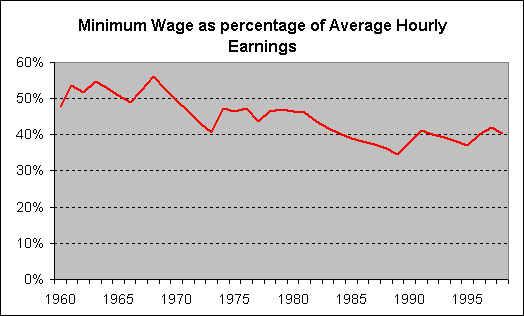
Just as a basic point of reference, I have
included below a graph showing the same data that was shown in the
very first graph, but with the average income of the top 400 from
2000 added to it to get an idea of scale. This is not a
completely accurate graph because it is using data from 2000 and
2001 together and because the top 400 are a component of the top 1%
so the top 400 income is part of the top 1% average, which brings
the average income of the top 1% up. In addition, I am using
gross pre-tax income for the 2001 data and AGI (which includes some
deductions) for the 2000 data. If I were staying true to form
then I should have a group of the top 1% minus the top 400, but I
simply do not have that data on hand, but this rough comparison is
good enough to get an idea of the differences in income among the
different groups. If all of the corrections were made to make the
top 400 data completely comparable to the 2001 data then the
differences would be even more pronounced, so this graph is not
quite as dramatic as it would be with totally accurate data.

Many "respected" institutions, such as CATO
are continuing to present information on taxation and income in a
biased and deceptive manner. Many politicians and media
pundits, and even financial analysts, are continuing to claim that
the tax burden has been increasing on the top 1% of tax
payers. Politicians often misrepresent information to upper middle
class voters telling them that taxes on the wealthy are too high and
thus high end taxes need to be cut. This message connects with
upper middle class tax payers because they
are actually the ones who really have been seeing an increase in the
tax burden, but what is not apparent is that that increase has not
come from the lower segments of income receivers, it has come from
above them from the top 1% of income recipients, whose tax burdens
have been pushed it off onto the upper middle class.
The assumption from people in the upper
middle class is that if taxes are getting worse for them, then they
must be getting even worse for those above them, but this is not the
case. The burden is really increasing on those people making
between about $60,000 and $150,000 or $200,000 a year, but once you
get above that into the $500,000+ a year incomes the tax burden has
been greatly reduced over the past 20 years.
From CATO:
http://www.cato.org/research/fiscal_policy/2002/factsfigs.html
"The highly graduated or "progressive"
nature of the federal individual income tax results in a very small
minority of Americans paying a massive share of the $1 trillion of
annual income tax revenues. The highest-income 1 percent of
households pay 36 percent of individual income taxes, and the top 5
percent of households pay 56 percent, based on the most recent IRS
statistics."
"The federal income tax burden has been
become increasingly skewed towards households with the highest
incomes. The share of all individual income taxes paid by the
highest-income 1 percent of households has increased from 19 percent
in 1980 to 36 percent in 1998."
This organization, which is a large and
respected one by many people and has powerful influence in economic
issues, is presenting a fallacy, and this fallacy is repeated by
thousands of other influential organizations and individuals in
America. Here I have presented the facts that prove beyond a
shadow of a doubt that this is incorrect. First of all they
are only presenting income tax information and income taxes are not
the only taxes that people pay. Total tax burden is what is
important, not just what the name is on the tax; ultimately tax is
tax, it all comes out of your paycheck and goes to government,
whether it's excise tax or income tax makes no difference at the end
of the day.
Secondly I have shown that even the income
tax system has been getting less progressive even since 1980, and it
was actually much more progressive from the time it was first
developed up to 1980. As the income tax system has gotten less
progressive over the past 20 years the share of income tax paid by
the top 1% has increased. Making the system less progressive
will not necessarily decrease the share of income taxes paid by the
top 1%. The primary reason that the share of taxes paid by the
top 1% has gone up over the past 20 years is because the incomes of
those in the top 1% have gone up at a rate much higher than that of
other Americans.
Over the past 20 years the salaries of corporate
executives have grown by a factor of more than 10. In 1982 the
average corporate executive was paid about 42 times the salary of
the average employee. In 2002 that figure had increased to 500 times
the compensation of the average employee.
Commenting on this turn of events, William J.
McDonough, chairman of the New York Federal Reserve Bank, said,
"I find nothing in economic theory that justifies this
development, I am old enough to have known both the CEOs of 20 years
ago and those of today. I can assure you that we CEOs of today are
not 10 times better than those of 20 years ago."
See:
Fed official decries CEO salaries
In February 2002 top economic officials met
to discuss corporate governance and the state of the American
economic system. The Chairman of the Federal Reserve, Alan
Greenspan, shared his view that there were fundamental problems with
corporate governance in America in how corporations and executives
have been manipulating the system for the past 20 years. Others in
the room tried to downplay his concerns. Dr. Greenspan would make is
point:
"There's been too much gaming of the
system until its broke. Capitalism is not working! There has been a
corrupting of the system of capitalism!"
- Dr. Alan Greenspan - Chairman of the Federal Reserve, February
22, 2002
This article is about income and taxation.
For related information on wealth and the economy see:
Understanding Capitalism Part I: Capital
and Society
|
 page views since January 21, 2004
page views since January 21, 2004